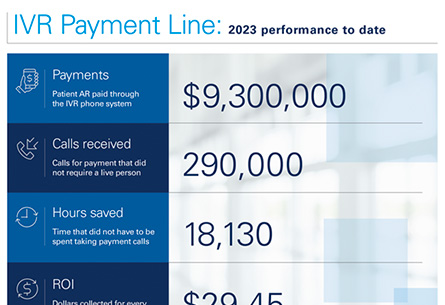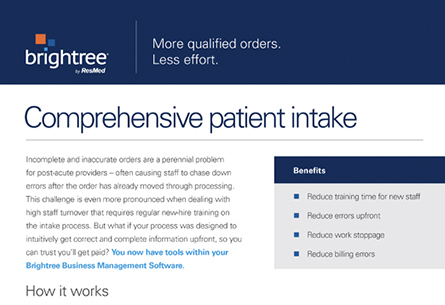Empower your remote staff: Brad Heath and Jerri McLamb tell you how.
Q: Tell me what about the business model and how it’s changed for you guys with COVID-19?
Brad: Well, it certainly changed in a hurry. One day, folks were walking in, and we were doing CPAP setups in the stores. The next day, all of our material stores were locked, and we were doing curbside service.
We were out on the curb with an over-bed table, and a CPAP machine doing drive through setups while social distancing. If anybody had the flu and needed a nebulizer, and they were considered to be potential for COVID-19, we were setting the nebulizer down in the parking lot six feet away from the car, and then they would come and get it after the fact. Folks were extremely courteous and have continued to be extremely courteous about the new method; everybody is taking this seriously.
All our processes for patient engagement and interactions had to be written, basically, within about 48 hours. It has put a lot of emphasis on follow-up. We’re checking in with them the next day, or two days later, and making sure that everything’s working like it should be. And I think a lot of those are things that won’t go away when this is over, from the follow-up perspective.
In terms of staffing, we’ve been sending employees home. Our home office has about 140 employees and 90% of those are home at this point. That didn’t happen all at once. It was over ten days as phones were adapted and integrated within our system. We had already built tracking for our phone calls and Brightree tasks with notes – which have certainly become more valuable than ever – and we’re seeing productivity.
Q: What have you found in the Brightree system that has made this process easier?
Jerri: With the revenue cycle worklist, the sales order worklist and being able to post your ERNs, Brightree’s always made it easy to be remote and it was easy to assign tasks to different employees. Also, having the ability to send tasks back and forth and having the coronavirus resource center in Brightree Community has been helpful. I know that I’ve had a lot of communication with different suppliers on what they’re doing during this time, and we’re all asking the same questions. It’s good to see what some of the other suppliers are doing – like what we’re doing – with the curbside service, mailing off the CPAPs and doing remote setups.
Some of the new things in the new release are also working out well. For example, having that ability to see the infectious control information immediately when you pull up a patient.
Q: What other adjustments have you made to your business during this time?
Jerri: For those that are on-site, every morning before they walk in the door, we’re doing a temperature check. The managers here all have a schedule of who’s doing the temperature check at what time. So, we check temperatures and when you have somebody that’s on that borderline, you say, “Okay, step back over there. We’re going to recheck it in a few minutes.” We haven’t had anyone we’ve had to send home. We’ve had a few cold mornings were employees have run their heat and we’ve just had to use a different thermometer to get their temperatures checked.
We’ve all been trying to keep connected with everybody, touching base with everybody working at home and making sure they’re not struggling with anything. Just trying to motivate people when you don’t see them is something that has been a challenge.
Brad: With our retail stores not open for retail, we’ve taken some of the CSRs that would be involved there and retrained them for key-ins. We’ve had some offshore positions that we have moved back during this time. We’re really trying to make sure that we’re taking care of our people.
It has allowed us to catch up on some things. We’ve had good growth, but really reallocating and moving resources around, training folks to do new things so that you can catch up anywhere in your business that may have been behind when you walked into this.
Q: What are some of your biggest surprises from COVID-19?
Jerri: My biggest surprises have been Medicare relaxing the LCDs, as well as the rate of the pandemic, the people that are getting sick, and the changes we’ve made to create social distancing. It’s heartbreaking to see the numbers.
As far as in our business, I think Medicare and CMS changing policy so quickly has been surprising. The bad thing is, we still don’t know how we’re going to get paid for a lot of this. They’re relaxing all these measures but none of the carriers know how to process the claims so we’re still hanging out on that tightrope.
So, that and trying to get used to the new normal: riding through your town and it seems like a ghost town because there’s nobody out and about.
Brad: Communities have come together. Industries have come together. There’s a lot of people out of work and that is a riddle we have to solve, but the creativity and adaptation people have used to continue to work has been has been a wonderful surprise in the midst of a very difficult time.
Folks have really embraced each other, in other ways. And with this industry as a whole, the ability to depend upon one another for best practices or finding PPE has been one of the most endearing things of this whole experience.
Q:Have you started thinking about what the return to work could look like?
Brad: At this point, I don’t think that we have. We had staff on-site and we found a way to get them home. We also had one person where it was better for them to work here and we got enough folks out to make that happen. So, we’re adjusting.
I think for us it’s really about answering, “how do we adjust on the patient-facing side to make that more normal again?” We serve some of the most susceptible patients so we’re not in a rush. We want to protect our people, and we also want to protect our patients.
So, when we have a 23-year-old technician going into the home of a 78-year-old COPD patient, they’re wearing that mask to protect the patient more than they are themselves – if they’re homebound, the patient isn’t seeing folks as it is.
We want to see businesses open. We want folks whose livelihoods work out. But we really are experiencing a new norm right now, and until we know that people in our part of the industry are not at risk.



